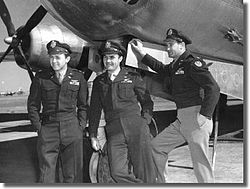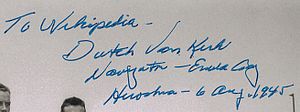- Theodore Van Kirk
-
Capt. Theodore Van Kirk United States Army Air Corps 
Van Kirk (left) with Tibbets, and FerebeeNickname 'Dutch' Born February 27, 1921
Northumberland, PennsylvaniaAllegiance  United States of America
United States of AmericaService/branch United States Army Air Forces Years of service 1941–1946 Rank Major Unit 97th Bomb Group
509th Bomb WingBattles/wars World War II Awards Silver Star
Distinguished Flying Cross
Air Medal(15).Theodore Van Kirk (born 27 February 1921 in Northumberland, Pennsylvania)[1] is a former United States Army Air Force navigator. He is famous as the navigator of the Enola Gay when it dropped the first atomic bomb on Hiroshima. With the death of fellow crewman Morris Jeppson (who died on March 30, 2010), Van Kirk is the last surviving member of the Enola Gay crew.
Contents
Early US Army career
Van Kirk joined the Army Air Force Aviation Cadet Program October 1941. On 1 April 1942 he received both his commission and navigator wings and transferred to the 97th Bomb Group, the first operational B-17 Flying Fortress unit in England. The crew of the "Red Gremlin" also included pilot Paul Tibbets and bombardier Tom Ferebee. Van Kirk would later fly with these men on the Hiroshima mission.
From August to October 1942 the crew flew 11 missions out of England. They were the lead aircraft, responsible for group navigation and bombing. In October 1942 they flew General Mark Clark to Gibraltar for his secret North African rendezvous with the French prior to Operation Torch. In November they ferried General Eisenhower to Gibraltar to command the North African invasion forces. After German reinforcements began pouring into the port of Bizerte, Tunisia, posing a serious threat to Allied strategy, a new mission emerged. On 16 November 1942 the crew led their group in an attack that took the Germans by surprise at Sidi Ahmed Air Base at Bizerte.
Atomic bombing of Japan
Van Kirk returned to the States in June 1943 after flying a total of 58 missions overseas.[2] He served as an instructor navigator until reuniting with Tibbets and Ferebee in the 509th Composite Group at Wendover Field, Utah, in late 1944. The group flew the Boeing B-29 Superfortress, with Tibbets as commander and Van Kirk as the group navigator. From November 1944 to June 1945 they trained continually for the first atomic bomb drop, which occurred 6 August 1945.
The thirteen-hour mission to Hiroshima began at 0245 hrs Tinian time. By the time they rendezvoused with their accompanying B-29s at 0607 hrs over Iwo Jima, the group was three hours from the target area. As they approached the target Van Kirk worked closely with the bombardier, Tom Ferebee, to confirm the winds and aimpoint. The bomb fell away from the aircraft at 0915:17 Tinian time. Van Kirk later participated in Operation Crossroads, the first Bikini Atoll atomic bomb tests. According to the 1995 New York Times interview by Gustav Niebuhr Mr. Van Kirk told he was often asked, "given a choice about his role in the Hiroshima bombing, would he do it again?":[3]
Under the same circumstances -- and the key words are 'the same circumstances' -- yes, I would do it again. We were in a war for five years. We were fighting an enemy that had a reputation for never surrendering, never accepting defeat. It's really hard to talk about morality and war in the same sentence. In a war, there are so many questionable things done. Where was the morality in the bombing of Coventry, or the bombing of Dresden, or the Bataan death march, or the Rape of Nanking, or the bombing of Pearl Harbor? I believe that when you're in a war, a nation must have the courage to do what it must to win the war with a minimum loss of lives.
In October 2007, Van Kirk auctioned off the flight log he kept on board the Enola Gay during the atomic bombing of Hiroshima for $US358,500 in a public auction. Van Kirk stated he decided to sell the log because he wants it to be kept at a museum. The auction house did not reveal the name of the successful bidder, although admitted it was a U.S. citizen.[4]
Later life
In August 1946 Van Kirk completed his service in the Army Air Force as a Major. His decorations include the Silver Star, the Distinguished Flying Cross and 15 Air Medals. Van Kirk went on to receive his Bachelor and Master of Science degrees in Chemical Engineering from Bucknell University in 1949 and 1950. For the next 35 years he held various technical and managerial positions in research and marketing with DuPont. Van Kirk was present at the 2008 Thunder over Michigan Air Show.
On August 21, 2010 Van Kirk appeared at a gun and knife collector's show in Dallas, TX where his autograph was obtained dedicated "To Wikipedia."
On September 3, 2010 Major Van Kirk, accompanied by his wife, appeared at the model air show "Warbirds Over Atlanta 2010" in Ball Ground, Georgia where he signed his books and photographs as a replica of the B-29 flew overhead.
See also
References
External links
- Annotated Bibliography for Theodore Van Kirk from the Alsos Digital Library for Nuclear Issues
- White Light/Black Rain Official Website (film)
- Interview with Theodore "Dutch" Van Kirk from National Public Radio "All Things Considered" program, 04 August 2005
- 'I'd drop atomic bomb on Hiroshima again if needed' - Enola Gay last living member
- Georgia Public Broadcast Interview Oral HIstory Project
- Video interview in August 2010 from the BBC
Categories:- 1921 births
- Living people
- American military personnel of World War II
- American people of Dutch descent
- Recipients of the Silver Star
- Recipients of the Distinguished Flying Cross (United States)
- People associated with the atomic bombings of Hiroshima and Nagasaki
- Navigators
- United States Army Air Forces officers
Wikimedia Foundation. 2010.

